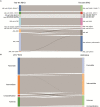The latest edition of WHO and ELN guidance and a new risk model for Chinese acute myeloid leukemia patients
- PMID: 37435533
- PMCID: PMC10332310
- DOI: 10.3389/fmed.2023.1165445
The latest edition of WHO and ELN guidance and a new risk model for Chinese acute myeloid leukemia patients
Abstract
Objective: Diagnosis classification and risk stratification are crucial in the prognosis prediction and treatment selection of acute myeloid leukemia (AML). Here, we used a database of 536 AML patients to compare the 4th and 5th WHO classifications and the 2017 and 2022 versions of ELN guidance.
Methods: AML patients were classified according to the 4th and 5th WHO classifications, as well as the 2017 and 2022 versions of the European LeukemiaNet (ELN) guidance. Kaplan-Meier curves with log-rank tests were used for survival analysis.
Results: The biggest change was that 25 (5.2%), 8 (1.6%), and 1 (0.2%) patients in the AML, not otherwise specified (NOS) group according to the 4th WHO classification, were re-classified into the AML-MR (myelodysplasia-related), KMT2A rearrangement, and NUP98 rearrangement subgroups based on the 5th WHO classification. Referring to the ELN guidance, 16 patients in the favorable group, six patients in the adverse group, and 13 patients in the intermediate group based on the 2017 ELN guidance were re-classified to the intermediate and adverse groups based on the 2022 ELN guidance. Regrettably, the Kaplan-Meier curves showed that the survival of intermediate and adverse groups could not be distinguished well according to either the 2017 or 2022 ELN guidance. To this end, we constructed a risk model for Chinese AML patients, in which the clinical information (age and gender), gene mutations (NPM1, RUNX1, SH2B3, and TP53), and fusions (CBFB::MYH11 and RUNX1::RUNX1T1) were included, and our model could help divide the patients into favorable, intermediate, and adverse groups.
Conclusion: These results affirmed the clinical value of both WHO and ELN, but a more suitable prognosis model should be established in Chinese cohorts, such as the models we proposed.
Keywords: European Leukemia Net; World Health Organization; acute myeloid leukemia; prognosis; risk model.
Copyright © 2023 Wang, Wang, Wei, Zhao, Xin, Li, Zhao, Wu, Luo, Zhao, Chen, Liu, Zhang, Wang, Wang, Wang, Xiong and He.
Conflict of interest statement
BX, GL, and HX were employed by Shanghai Yuanqi Biomedical Technology Co., Ltd. The remaining authors declare that the research was conducted in the absence of any commercial or financial relationships that could be construed as a potential conflict of interest.
Figures




Similar articles
-
Reclassification of Acute Myeloid Leukemia According to the 2022 World Health Organization Classification and the International Consensus Classification Using Open-Source Data.Ann Lab Med. 2025 Mar 1;45(2):170-177. doi: 10.3343/alm.2024.0194. Epub 2024 Dec 16. Ann Lab Med. 2025. PMID: 39676421 Free PMC article.
-
Validation of the prognostic significance of the 2022 European LeukemiaNet risk stratification system in intensive chemotherapy treated aged 18 to 65 years patients with de novo acute myeloid leukemia.Am J Hematol. 2023 May;98(5):760-769. doi: 10.1002/ajh.26892. Epub 2023 Mar 13. Am J Hematol. 2023. PMID: 36861732
-
Assessment of 2022 European LeukemiaNet risk classification system in real-world cohort from China.Cancer Med. 2023 Dec;12(24):21615-21626. doi: 10.1002/cam4.6696. Epub 2023 Dec 14. Cancer Med. 2023. PMID: 38098254 Free PMC article.
-
A Review of Childhood Acute Myeloid Leukemia: Diagnosis and Novel Treatment.Pharmaceuticals (Basel). 2023 Nov 15;16(11):1614. doi: 10.3390/ph16111614. Pharmaceuticals (Basel). 2023. PMID: 38004478 Free PMC article. Review.
-
Comparative Analysis of AML Classification Systems: Evaluating the WHO, ICC, and ELN Frameworks and Their Distinctions.Cancers (Basel). 2024 Aug 22;16(16):2915. doi: 10.3390/cancers16162915. Cancers (Basel). 2024. PMID: 39199685 Free PMC article. Review.
Cited by
-
Coexistence of acute myeloid leukemia with a complex chromosomal translocation and monoclonal gammopathy of undetermined significance: A case report and literature review.Oncol Lett. 2025 Mar 7;29(5):224. doi: 10.3892/ol.2025.14970. eCollection 2025 May. Oncol Lett. 2025. PMID: 40110581 Free PMC article.
-
[Screening of MLL fusion genes and rare breakpoint cases in patients with acute myeloid leukemia].Zhonghua Xue Ye Xue Za Zhi. 2025 Apr 14;46(4):349-354. doi: 10.3760/cma.j.cn121090-20240407-00125. Zhonghua Xue Ye Xue Za Zhi. 2025. PMID: 40425457 Free PMC article. Chinese.
-
Establishment and validation of a gene mutation-based risk model for predicting prognosis and therapy response in acute myeloid leukemia.Heliyon. 2024 May 15;10(10):e31249. doi: 10.1016/j.heliyon.2024.e31249. eCollection 2024 May 30. Heliyon. 2024. PMID: 38831838 Free PMC article.
-
Reclassification of Acute Myeloid Leukemia According to the 2022 World Health Organization Classification and the International Consensus Classification Using Open-Source Data.Ann Lab Med. 2025 Mar 1;45(2):170-177. doi: 10.3343/alm.2024.0194. Epub 2024 Dec 16. Ann Lab Med. 2025. PMID: 39676421 Free PMC article.
-
Acute myeloid leukemia and myelodysplastic neoplasms: clinical implications of myelodysplasia-related genes mutations and TP53 aberrations.Blood Res. 2024 Dec 18;59(1):41. doi: 10.1007/s44313-024-00044-4. Blood Res. 2024. PMID: 39692933 Free PMC article.
References
-
- Nagel G, Weber D, Fromm E, Erhardt S, Lubbert M, Fiedler W, et al. . Epidemiological, genetic, and clinical characterization by age of newly diagnosed acute myeloid leukemia based on an academic population-based registry study (Amlsg Bio). Ann Hematol. (2017) 96:1993–2003. 10.1007/s00277-017-3150-3 - DOI - PMC - PubMed
LinkOut - more resources
Full Text Sources
Research Materials
Miscellaneous

